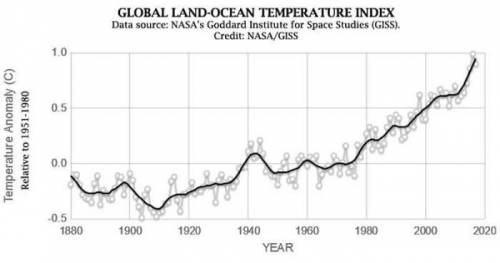Fill in the table below based on the global temperature record:
Time period Number of yea...

Physics, 05.05.2020 16:29 1232444553
Fill in the table below based on the global temperature record:
Time period Number of years with mean Temp. > 0° to +1° above mean Number of years with mean Temp. more than +1° above mean Number of years with mean Temp. < 0° to -1° below mean
1880-1899 0 0 20
1900-1919
1920-1939
1940-1959
1960-1979
1980-1999
2000-2019
Have global temperatures risen or fallen since 1900, and how much have they changed (how many temperature degrees) .
What is the size of the overall temperature changes in USA (how many degrees has it changed, see previous graph!) and how does this compare to the size of the global temperature change calculated in the previous question?
Are the years with the highest and lowest annual temperatures the same on both graphs (are the same in the USA versus in the world)? If not how much do they differ?
Are the points with the highest and lowest 5 year average temperatures the same on both graphs? If not how much to they differ (i. e. how much time is there between them)?
Suggest a reason why mean annual temperature in USA may differ from mean global temperature. (Hint: think about USA’s geographic position on earth, how is USA different from the average values you would get looking at all of earth, what’s special about it)


Answers: 3


Another question on Physics

Physics, 21.06.2019 22:00
There is a theory that indicates that dinosaurs became extinct when about 65 million years ago, a large asteroid hit the earth surface. dust caused by this collision blocked the sunlight reaching the earth's surface and many forms of life became extinct due to the cold. fearing this threat, how large the radius of an asteroid should you be looking for if the dangerous asteroid size is approximately the same as the one that killed the dinosaurs? available data suggests that about 18% of that asteroid's mass ended up as a dust spread evenly over earth after eventually settling out of the upper atmosphere. about 0.0180 g/cm^2 of dust, which is chemically different than the earth's rock, covered the earth's surface. typical asteroids have a density of about 1.9 g/cm^3. now that we know the size of the asteroid, how much energy was released during impact, assuming all of it was just the kinetic energy of the asteroid right before the impact?
Answers: 1

Physics, 22.06.2019 00:30
Which is not one of the major climate zones? question 3 options: rain forest polar tropical temperate
Answers: 1

Physics, 22.06.2019 07:20
If the ama of the inclined plane below is 2, calculate the ima and efficiency. ima = efficiency =
Answers: 1

Physics, 22.06.2019 14:10
The number of passengers who arrive at the platform of a subway station for the 10 am train is a random variable with a mean of 120 and a variance of 16. find the lower bound of the probability that there will be between 100 and 140 passengers (round off to second decimal place).
Answers: 3
You know the right answer?
Questions





Chemistry, 23.10.2019 09:50


Arts, 23.10.2019 09:50

Chemistry, 23.10.2019 09:50






Social Studies, 23.10.2019 09:50

Mathematics, 23.10.2019 09:50




World Languages, 23.10.2019 09:50



